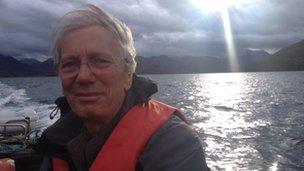DIY broadband in the Highlands
- Published
- comments
Sheep farmer Iain Wilson - Britain's most remote broadband user?
Live in a remote part of Britain and want superfast broadband? Well you could wait until BT, Virgin or some government-funded scheme hooks you up - or you could just do it yourself.
That's what a project called Tegola has done, beaming broadband from a college on the Isle of Skye to a number of remote communities which would otherwise be left without a decent internet connection.
I visited one of them - Arnisdale - in a journey around Broadband Britain four years ago, external. Now I've been back, and gone further in search of the UK's most remote broadband customer.
Accompanied by Peter Buneman, the Edinburgh computer scientist who got the Tegola project going, I cross the loch to the Knoydart peninsula.
There we find Iain Wilson who farms sheep over 3,000 acres of extraordinarily beautiful but rugged countryside, with no roads and no mains power. His farmhouse relies on his own home-made hydroelectric unit for power, and his sheep go to market by boat.
It is difficult to imagine anywhere on the mainland with less access to basic amenities - but then Mr Wilson shows me his broadband. It is faster than many in the city, and good enough for a video chat with his son in Australia.
A small receiver on the hill behind the house picks up the wireless broadband signal from Skye, and as he is one of the first in the chain, he gets some of the best speeds.

Computer scientist Peter Buneman is bringing broadband to the Scottish highlands
But it all involves pitching in, building the mast and mending it - with instructions from Peter Buneman - when something goes wrong.
This broadband connection and a few hundred others across the Tegola network - which now includes the island of Eigg - seems to be living evidence that small is beautiful.
Peter Buneman told me he'd once had a conversation with a major broadband company about Mr Wilson's mast on Knoydart.
The firm had laughed at the idea they would ever put a mast somewhere so isolated - and explained that if something went wrong with it they would have to fly an engineer over in a a helicopter at a cost of £3,000.
The Tegola project has not been expensive - it started with an academic research grant. A local fish farm has chipped in with some help, and the users now pay a voluntary £10 a month subscription.
On Skye today community broadband activists gather for a conference to learn from successful projects like this. But Peter Buneman, who has done some much to bring broadband to Arnisdale, Knoydart and beyond, isn't satisfied that the job is done.
He says the key is fibre - getting a superfast connection to a hub like the Gaelic College and then spreading it wirelessly to places which will otherwise miss out.
He foresees a national network of open-access fast fibre hubs at schools, hospitals and community centres. This was the idea backed in a House of Lords report on superfast broadband earlier this year.
Another vocal supporter for that approach is Chris Conder, a campaigner from Lancashire who is in Skye for today's conference.
She arrives at the Gaelic College to join me in a live broadcast this morning, complete with the fibre, ducts and pipes which the B4RN community broadband project uses to hook up local farms to a superfast network.
From Skye to Knoydart to Lancashire one message comes through loud and clear: if you want fast broadband and you live in the country you may have to get your hands dirty and do it yourself.